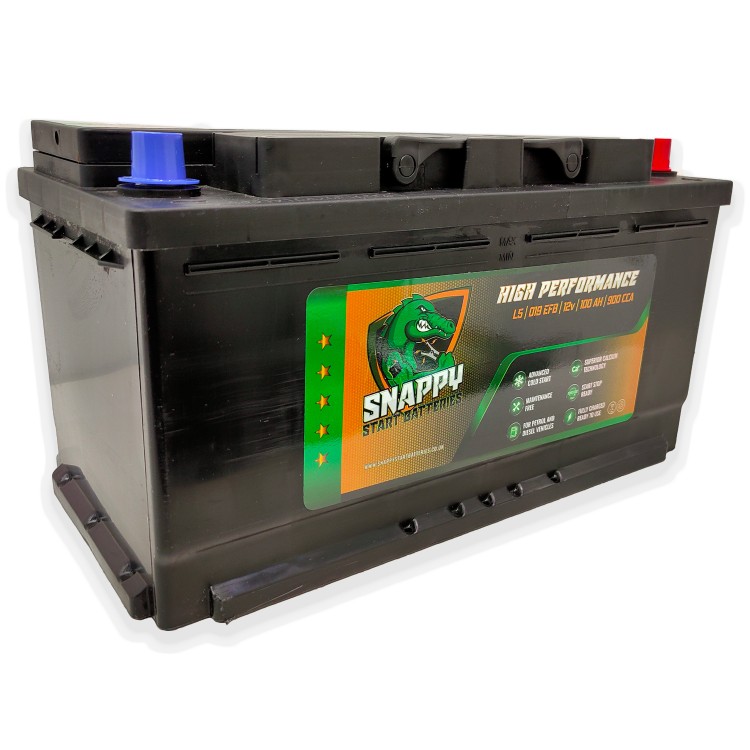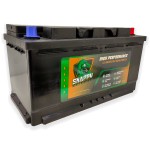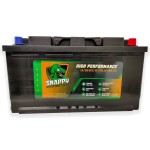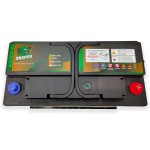Snappy 110AH Leisure Battery
Power
Warranty
(Including VAT)
Qty
Ask about this productHave a question?
Snappy Battery Warranty
- Depending on the battery you've bought, it'll have a warranty period of 2/3/4/5 years. Have a look at the label on your new battery to find out how long your battery's warranty is.
- Your battery warranty isn't transferable between vehicles.
How does the warranty work?
- The warranty covers any manufacturing defects, which arise within the warranty period.
- In the unlikely event you experience a problem with your battery, please return the battery to us along with proof of purchase. Unfortunately, we're unable to offer a replacement battery without a dated proof of purchase.
- We'll carry out a complete health check on the battery, which will indicate if there's a fault with the battery; the results of our battery check are final.
- If the battery's found to be faulty, we'll happily replace it for you.
- If you experience any problems with your battery, which haven't arisen as a result of a manufacturing defect, we're unable to provide a replacement battery.
- The warranty on any replacement battery will expire on the original battery's warranty expiry date.
What isn't covered by the warranty?
The following may cause your battery to become damaged. As these issues are not manufacturing defects, they aren't covered by the warranty:
- Sulphation: This tends to happen if your vehicle isn't driven for extended periods.
- Deep cycling: This can happen if the vehicle's engine is started very frequently or electrical consumers are left on for extended periods between journeys.
- Overcharging: This is usually caused by a fault in the vehicle's charging system.
- Physical damage: This can be caused by incorrect handling or storage.
- Incorrect application: Make sure you're using the battery that Snappy recommends for your vehicle!
- Wear and tear caused by misuse.
Your statutory rights remain unaffected
Having trouble deciding on the right battery for your vehicle? A 110ah battery could be just what you need. This blog will guide you through choosing, using, and maintaining these powerful batteries.
Keep reading to find out more!
Understanding 110ah batteries
Exploring 110ah batteries reveals their unique capacity for energy storage. They power up various devices, from solar panels to RVs, with efficiency and reliability.
What is a 110ah battery?
A 110ah battery stands for a power inverter unit with a capacity of 110 ampere-hours. This means it can deliver 110 amps of current for one hour or another rate like 1 amp for 110 hours before needing a recharge.
They're commonly used in vehicles and various electronic setups due to their high capacity and durability.
Vehicle owners favor these batteries because they offer reliable start-up power and a long-lasting energy supply, essential for cars, trucks, RVs, and boats. The versatility of these batteries extends beyond just starting engines; they also power tools when the engine is off, making them ideal for how to use a car's battery for power solutions.
Types of 110ah batteries (SLA, Gel, Lithium)
Selecting the right 110ah car battery involves understanding the different types available. Each type offers unique benefits suitable for various applications, from solar power setups to powering your RV on long trips. Here's a breakdown of the three main types:
- SLA (Sealed Lead Acid) Batteries: These batteries are known for their reliability and affordability. They work well in a wide range of temperatures and environments, making them a solid choice for vehicle owners who need a dependable power source. SLA batteries require minimal maintenance, as their sealed design prevents leakage and reduces the risk of spills.
- Gel Batteries: Featuring a silica-based electrolyte that turns into a gel-like substance, these batteries offer excellent resistance to vibration and shock. This makes them ideal for off-road vehicles or boats where movement is constant and unpredictable. Gel batteries also perform exceptionally well in extreme temperatures, both hot and cold, and come with a higher price tag due to their specialized design.
- Lithium Batteries: For those seeking the latest in battery technology, lithium batteries stand out for their lightweight design and high energy density. They charge faster than their SLA and Gel counterparts and have a longer lifespan, reducing the need for frequent replacements. Although they are the most expensive option among 110ah car batteries, their efficiency and durability make them a worthwhile investment for tech-savvy vehicle owners.
Each type of 110ah battery caters to specific needs and preferences, making it crucial to evaluate your requirements before making a decision.
Next up, let's explore why these advantages make 110ah batteries an essential choice for vehicle owners looking for reliable power solutions.
Applications (solar, wind, RV)
110ah batteries are a top choice for powering a wide range of applications. Vehicle owners find these batteries reliable for various uses beyond just starting engines. Here's a closer look at how they serve different needs:
- Solar Power Systems: 110ah batteries store energy generated from solar panels during the day. At night or on cloudy days, this stored power keeps lights on and appliances running in homes and businesses.
- Wind Energy Storage: Similar to solar systems, these batteries capture and store power generated by wind turbines. This makes wind energy a viable option even when the wind isn't blowing.
- Recreational Vehicles (RV): For those who love road trips and camping, 110ah batteries provide the necessary power. They run everything from lights to refrigerators in RVs, ensuring comfort on the move.
- Backup Power: In areas prone to power outages, a 110 car battery can be a lifesaver. It ensures that essential devices remain operational during emergencies.
- Marine Applications: Boats and yachts also benefit from 110ah batteries. They power navigation systems, onboard appliances, and safety precautions and equipment while at sea.
- Off-Grid Living: For individuals living off the grid, these batteries are crucial. They offer a dependable source of electricity without connection to utility services.
Exploring these applications shows just how versatile 110ah batteries can be for vehicle owners and beyond. Moving forward, let’s examine the advantages that make these batteries an excellent choice for such diverse needs.
Advantages of 110ah batteries
110ah batteries offer impressive benefits for vehicle owners. Their ability to recharge gives them a versatile edge, making them an ideal choice for various applications.
Rechargeable and versatile
Rechargeable 110ah batteries offer a powerful advantage for vehicle owners. They can be charged multiple times, saving you from the constant cost and hassle of purchasing new ones.
This feature makes these batteries an eco-friendly option, reducing waste and promoting sustainable practices. Additionally, their versatility shines through as they power a wide range of applications, from solar panels to wind turbines and even recreational vehicles (RVs).
Their ability to adapt across different devices ensures they meet the diverse potential energy needs of modern users.
With such flexibility at hand, these batteries also handle shocks and vibrations well. This durability is crucial for applications in moving vehicles or outdoor setups exposed to elements.
The transition into discussing how these batteries resist environmental stressors further accentuates their suitability for challenging conditions.
Resistant to shocks and vibrations
110ah batteries stand up well to rough conditions. They can handle bumps and jostles that come from being on the road in vehicles. This makes them ideal for cars, RVs, and other mobile applications where movement is constant.
Their design focuses on durability, ensuring they remain operational even when things get shaky.
These batteries also maintain their performance when exposed to vibrations that might damage less sturdy options. This characteristic is particularly valuable in settings like construction sites or off-road adventures where equipment frequently encounters unpredictable terrain.
By resisting shocks and vibrations, 110ah batteries provide reliable power without interruption, keeping your vehicle running smoothly no matter where the journey takes you.
Long-lasting performance in extreme temperatures
110ah batteries shine in their ability to perform reliably under extreme temperature conditions. Whether exposed to scorching heat or freezing cold, these batteries maintain their efficiency.
This durability makes them an excellent choice for vehicle owners who experience a wide range of weather conditions.
Their design allows them to resist the effects of temperature fluctuations better than many other types of car batteries. As a result, whether you're charging your 110ah battery in summer's peak or using it during a winter chill, you can expect consistent performance and reliability.
This quality ensures that your vehicle remains operational and ready to go regardless of the thermometer reading.
Suitable for various backup systems
110ah batteries make a great choice for backup systems in homes, offices, and outdoor adventures. Their reliability means you can depend on them to keep your crucial devices running during power outages or off-grid situations.
These batteries smoothly integrate with solar panels or generators, providing a seamless energy solution that keeps lights on and appliances working.
Owners of recreational vehicles (RVs) value 110ah batteries for their ability to support life off the beaten path. They ensure that essential gadgets remain charged and operational no matter where the road leads.
This versatility makes 110ah batteries ideal for anyone needing dependable power back-up options across different settings.
How to choose the right 110ah battery
Picking the right 110ah battery involves matching it to your specific needs. Look for brands like Interstate and Mighty Max that are known for reliability, and read through customer reviews to gauge performance.
Consider the intended use
Choosing the right 110ah battery starts with understanding its intended use. Each type of vehicle or application might require a different kind of power source. For example, if you need a car battery 110ah, you're likely looking for something that can handle frequent starts and stops.
On the other hand, applications like solar energy storage or powering an RV demand batteries that excel in deep-cycle use, where they are regularly drained and recharged.
Knowing what your battery needs to do helps narrow down your choices. A 110ah battery used for a wind energy system has very different performance expectations than one used in a weekend getaway RV.
So, before deciding on which brand or model fits best - whether it's Interstate or Mighty Max - make sure it matches the specific demands of your vehicle or project. This ensures not only peak performance but also maximizes the lifespan of your investment.
Check for reliable brands (Interstate, Mighty Max)
Picking a reputable brand is key for ensuring your 110ah battery lasts and performs well. Brands like Interstate and Mighty Max stand out for their commitment to quality and reliability.
They produce batteries that are compatible with various applications, including solar panels, wind systems, and recreational vehicles. Their products often come with warranties that give you peace of mind.
Interstate and Mighty Max have built solid reputations over the years by providing customers with durable batteries designed for long-term use. These brands focus on creating batteries that can withstand harsh conditions while maintaining optimal performance.
By choosing either Interstate or Mighty Max, vehicle owners ensure they're getting a product that won't let them down when they need it most.
Understand the technical specifications
Knowing the technical specs of a 110ah battery is crucial for optimal performance and longevity. Pay attention to the amp-hours rating, which tells you how much electricity it can store and deliver over time.
This detail helps determine how long your battery will last before needing a recharge.
Voltage compatibility with your vehicle matters too. It is crucial to meet the criteria as to not fit a battery with a low voltage parameter. Make sure the 110ah battery fits your system's requirements to avoid damage or inefficiency. Check the size and weight specifications as well, ensuring it will physically fit where you intend to install it.
Lastly, review the charge times; understanding how long to charge a 110ah battery ensures you keep it ready without overcharging.
Research customer reviews and ratings
After you understand the technical specifications of 110ah batteries, it's time to look into customer reviews and ratings. Real-life feedback can give you insight into how a battery performs under various conditions.
People often share their experiences regarding the battery's durability, how long to charge 110ah battery fully, and its overall reliability. This information is invaluable because it comes from users who have already put these batteries to the test in real-world scenarios.
Reading through reviews also helps identify any common issues with specific brands or models. Vehicle owners like you can make better decisions by learning about others' successes and challenges with certain batteries.
Pay close attention to comments on customer service and warranty claims; great post-purchase support can be a deciding factor in choosing the right 110ah battery for your vehicle.
Care and maintenance for 110ah batteries
Keeping your 110ah battery in top shape involves simple steps that ensure its longevity and performance.
Properly charging the battery
Charging your 110ah battery correctly ensures it lasts longer and performs better. Always use a charger that matches the battery type, like SLA, Gel, or Lithium, to prevent damage.
Follow the manufacturer's instructions on charging times and cycles closely. This practice helps maintain the battery's health and efficiency.
Never let your 110ah battery drain completely before recharging it. Doing so can significantly shorten its lifespan. Aim to recharge your battery when it drops below 50% capacity. This habit prevents deep discharge issues and keeps your vehicle running smoothly without unexpected downtimes or power losses.
Regularly monitoring charge levels contributes to optimal performance and longevity of the battery.
Storing in a cool, dry place
Keeping your 110ah battery in a cool, dry place helps maintain its charge and extends its life. Exposure to high temperatures can speed up the chemical reaction inside the battery, leading to faster self-discharge rates and potential damage.
Similarly, moisture can cause corrosion on the terminals and shorten the battery's lifespan. Ensuring your battery stays in an appropriate environment prevents these issues.
Next up: Regularly inspecting and cleaning your 110ah battery is crucial for optimal performance.
Regularly inspecting and cleaning
After ensuring your 110ah battery is stored correctly, it's crucial to maintain its cleanliness and check it regularly for any signs of wear or damage. Dirt and debris can accumulate on the battery negative terminal and positive terminal over time, causing poor connections that might lead to power issues in your vehicle.
Use a clean cloth to wipe off any dirt from the terminals and check for corrosion. If you spot any, gently clean it with a mixture of baking soda and water.
Alongside cleaning, inspecting your battery for leaks or swelling helps catch problems before they worsen. Swollen batteries can indicate overcharging or failure within the battery itself, necessitating professional advice or replacement.
By keeping an eye on these aspects, you help ensure the longevity and reliability of your 110ah battery, supporting optimal performance in various applications such as solar setups, wind energy systems, or RVs.
Replacing when necessary
Keeping your vehicle's 110ah battery in top shape is critical for performance. Replace the second battery as soon as you notice signs of declining power or inability to hold a charge. Ignoring these warnings could lead to unexpected breakdowns or insufficient power supply for your needs.
Check the manufacturer’s guidelines for battery lifespan and schedule inspections accordingly. Doing so ensures that your vehicle runs smoothly and reduces the risk of being stranded due to a dead battery.
Replacement isn’t just about solving immediate issues; it's also part of preventive maintenance that extends the life and efficiency of your vehicle's electrical system.
Conclusion
Choosing the right 110ah battery boosts your vehicle's reliability and performance. These batteries offer power for a variety of applications, from solar energy systems to recreational vehicles.
They stand out because they recharge well, resist damage from rough conditions, and work in extreme temperatures. Proper care extends their life even further, ensuring you get the most out of your investment.
Opting for a quality 110ah battery means choosing lasting efficiency and peace of mind for all your power needs.
FAQs
1. What does 110ah mean for a battery?
The "110ah" means the battery can supply 110 ampere-hours of power.
2. Can I use a 110ah battery in my car?
Yes, you can use a 110ah battery in your car if it matches the vehicle's specifications.
3. How long does a 110ah battery last?
A 110ah battery's lifespan depends on how often and how heavily it is used.
4. Is charging a 110ah battery easy?
Charging a 110ah battery is straightforward with the right charger and instructions.
5. Can I replace my old RV battery with a new 110ah one?
Yes, you can replace your old RV battery with a new 110ah one if it fits and meets the power requirements.
Can be used as an upgrade or alternative to :
Banner P8014, 58014, RP80
Bosch S3 010, S4 010, S5 010
Duracell DA80
Exide EB802, 110SE
Exide EA852, 110TE
Lucas LS110, LP110, LC110
Numax 110,
Oldham 110A
Platinum 110E
Varta 580 406 074, 585 200 080
Varta Short code F17, F18
Yuasa YBX3110, YBX5110
GS Yuasa SMF110
| Battery Code | 100/110 Leisure Battery |
| Technology | WET (Lead Acid) |
| Voltage | 12v |
| No. of Cycles | 150+ |
| Power Capacity (c20) | 100 ah |
| Capacity (c100) | 110 ah |
| CCA (cold cranking amps) | 850 cca |
| Weight (kg) | 24.5 kg |
| Length (mm) | 353 mm |
| Width (mm) | 175 mm |
| Height (mm) | 175 mm |
| Recommended Charge Rate (AH) | 7.4 ah |
| Terminal Layout | (+) on right side |
| Terminals | DIN Post |
| Warranty | 4 Years |

























































































